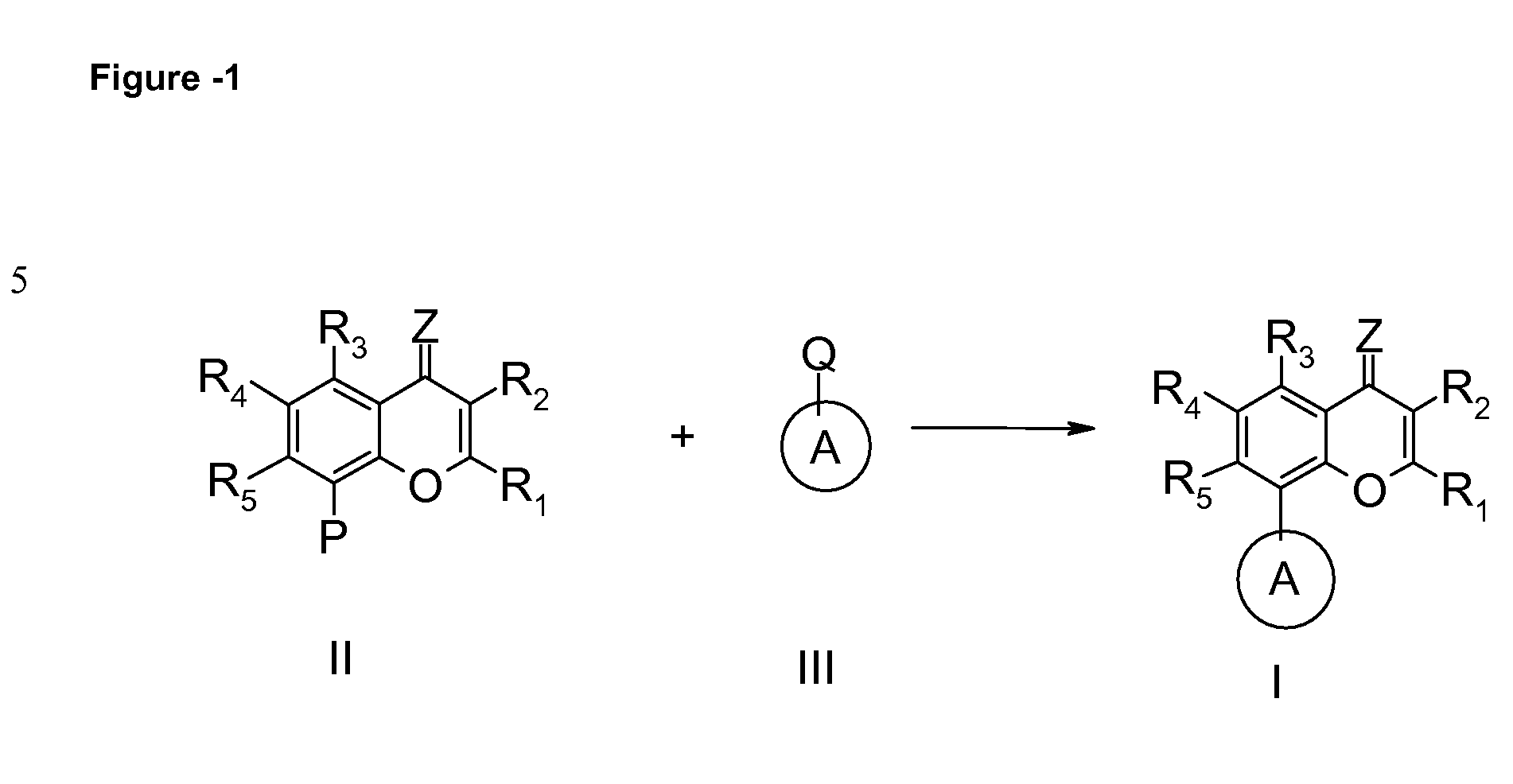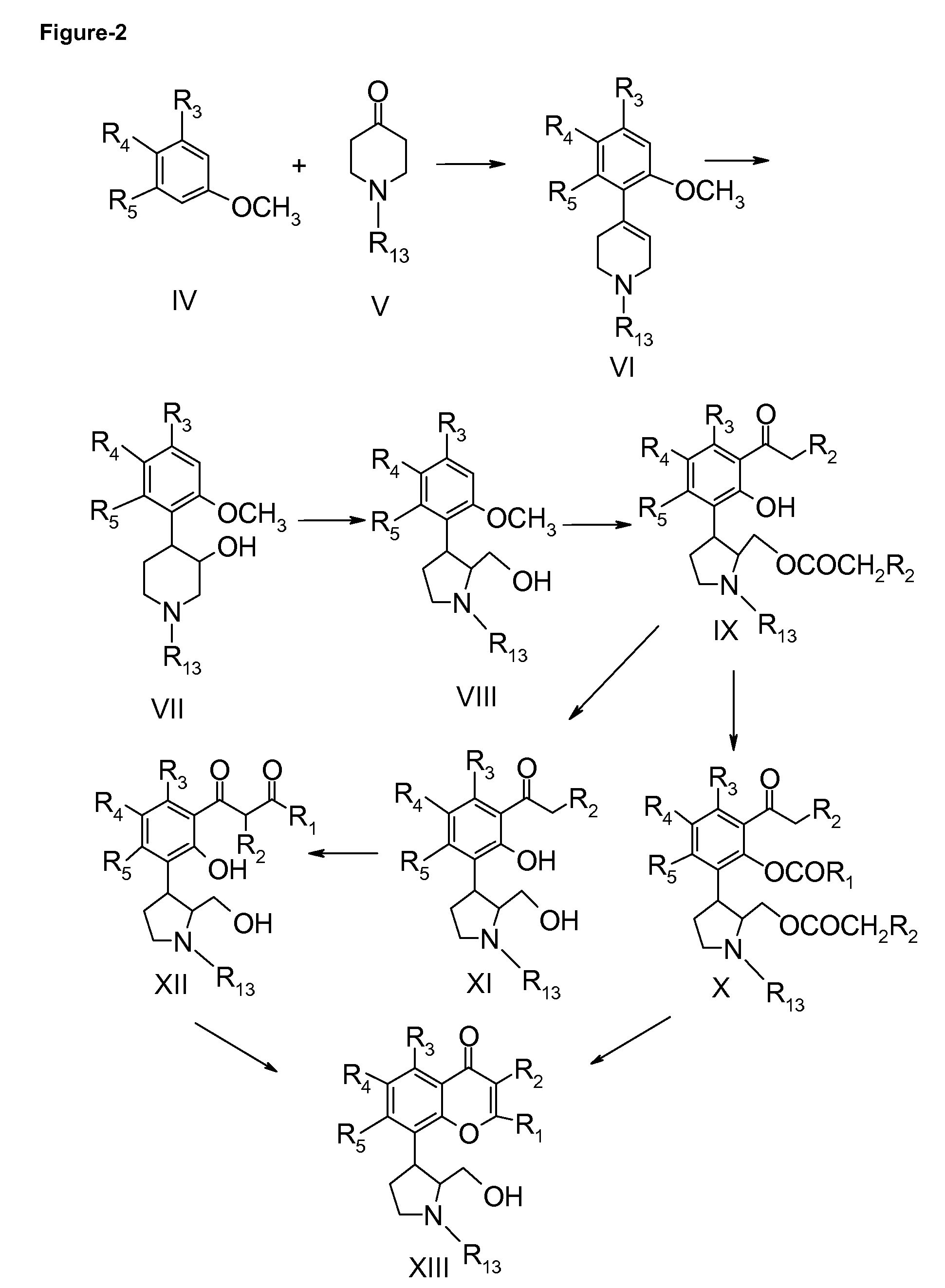Inhibitors of cyclin dependent kinases and their use
a cyclin-dependent kinase and inhibitor technology, applied in the field of inhibitors of cyclin-dependent kinases, can solve the problems of contributing to uncontrolled cell proliferation, and achieve the effect of preventing dedifferentiation of such cells and preventing excessive proliferation of eukaryotic cells
- Summary
- Abstract
- Description
- Claims
- Application Information
AI Technical Summary
Benefits of technology
Problems solved by technology
Method used
Image
Examples
example 1
1-Methyl-4-(2,4,6-trimethoxy-phenyl)-1,2,3,6-tetrahydro-pyridine
[0302] 1-methyl-4-piperidone (340 g, 3.0 mol) was added slowly, to a solution of 1,3,5-trimethoxybenzene (500 g, 2.97 mol) in glacial acetic acid (600 mL), maintaining the temperature of the reaction mixture below 40° C. Conc. HCl (450 mL) was added over 20 min. The temperature was raised to 85-90° C. and the reaction mixture was stirred for 3.5 h. It was allowed to cool to 40° C., poured over crushed ice (4 kg) and stirred for 20 min. The precipitate of unreacted 1,3,5-trimethoxybenzene was filtered off. The filtrate was basified, below 10° C., to pH 11-12 using a 50% aqueous NaOH solution. The off white solid obtained was filtered, washed with water and dried to obtain the compound, 1-Methyl-4-(2,4,6-trimethoxy-phenyl)-1,2,3,6-tetrahydro-pyridine.
[0303] Yield: 580 g (74%); mp: 112-114° C.
[0304] IR cm−1: 3045, 2900, 2837, 1600, 1585.
[0305]1H NMR (CDCl3): δ 6.15 (s, 2H), 5.55 (s, 1H), 3.85 (s, 3H), 3.75 (s, 6H), 3.1...
example 2
(±)-trans-1-Methyl-4-(2,4,6-trimethoxy-phenyl)-piperidin-3-ol
[0307] Boron trifluoride diethyl etherate (300 mL, 2.37 mol) was added slowly with stirring, under an atmosphere of nitrogen, at 0° C., to a solution of the compound of example (1) (300 g, 1.14 mol) and NaBH4 (75 g, 1.97 mol) in dry THF (2.25 L). The temperature of the reaction mixture was slowly raised to 55° C. and stirred for 1.5 h. It was cooled to 30° C. Ice cold water (100 mL) was slowly added followed by acidification with conc. HCl (375 mL). The reaction mixture was stirred for 1 h. at 50-55° C. It was cooled to 30° C. and basified using 50% aqueous NaOH solution to pH 11-12. Hydrogen peroxide (30%, 225 mL) was added over 0.5 h. The reaction mixture was stirred at 55-60° C. for 1.5 h. It was cooled to 30° C. and sufficient water added to dissolve the precipitated salts. The organic layer was separated and the aqueous portion extracted with EtOAc (2×1 L). The organic extracts were dried (anhydrous Na2SO4) and conce...
example 3
(±)-trans-Acetic acid 1-methyl-3-(2,4,6-trimethoxy-phenyl)-pyrrolidin-2-yl methyl ester
Method A:
[0312] Distilled triethyl amine (344 mL, 2.49 mol) was added slowly to a solution of compound of example 2 (350 g, 1.25 mol) in dry CH2Cl2 (2.5 L). To the reaction mixture methanesulfonyl chloride (122 mL, 171.1 g, 1.49 mol) was added with stirring, at 0° C., under an atmosphere of N2 and over a period of 20 min. The reaction mixture was further stirred for 1 h at 0° C. It was poured over saturated aqueous NaHCO3 solution (1.5 L). The organic layer was separated, washed with brine, dried (anhydrousNa2SO4) and concentrated to obtained a residue. This was dissolved in distilled isopropyl alcohol (1.5 L), anhydrous sodium acetate (408 g, 4.97 mmol) was added and the reaction mixture was refluxed for 1 h. It was cooled to room temperature. Sodium acetate was filtered off and washed with CHCl3. The filtrate was concentrated to obtain the title compound, which was purified using a silica gel...
PUM
| Property | Measurement | Unit |
|---|---|---|
| Molar density | aaaaa | aaaaa |
| Molar density | aaaaa | aaaaa |
| Molar density | aaaaa | aaaaa |
Abstract
Description
Claims
Application Information
 Login to View More
Login to View More - R&D
- Intellectual Property
- Life Sciences
- Materials
- Tech Scout
- Unparalleled Data Quality
- Higher Quality Content
- 60% Fewer Hallucinations
Browse by: Latest US Patents, China's latest patents, Technical Efficacy Thesaurus, Application Domain, Technology Topic, Popular Technical Reports.
© 2025 PatSnap. All rights reserved.Legal|Privacy policy|Modern Slavery Act Transparency Statement|Sitemap|About US| Contact US: help@patsnap.com



